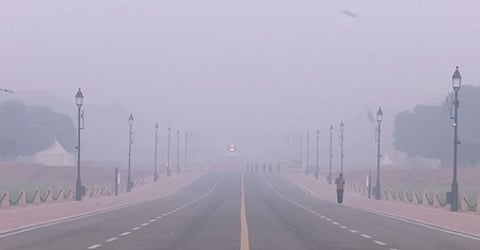Why Delhi air quality plunged after Diwali despite ‘green’ crackers
Cleaner fireworks were meant to cut pollution — but morning after told a different story

New Delhi: Delhi woke up on Tuesday to a blanket of thick, grey smog — the familiar post-Diwali haze that once again smothered the city despite the Supreme Court’s order allowing only “green” firecrackers.
The night sky had glowed with rockets and colourful fireworks, but by dawn the air had turned heavy, hazy, and hard to breathe. At 8 a.m., the national capital’s Air Quality Index (AQI) stood at 350, categorised as “very poor.”
Across the city, 36 of 38 monitoring stations entered the red zone, with areas such as Dwarka (417), Ashok Vihar (404), Wazirpur (423) and Anand Vihar (404) touching “severe” levels. By late morning, visuals from Akshardham and India Gate revealed a city cloaked in haze.
Polluted mornings: A recurring Diwali trend
Post-Diwali pollution spikes have become an annual ritual for Delhi.
Nov 1, 2024: AQI 359, per SAFAR data.
Nov 13, 2023: AQI 438, after residents defied the cracker ban.
Oct 25, 2022: AQI 315 (very poor).
Nov 5, 2021: AQI 454 (severe), with widespread ban violations.
At Anand Vihar, one of Delhi’s most polluted spots, AQI this year reached 360, barely an improvement over previous years (396 in 2024, 312 in 2023, 356 in 2022).
Also Read: Eat carrots, sing or pray in Delhi’s smog
Green crackers: A promise that failed to deliver
The Supreme Court first imposed a ban on firecrackers in 2014–15, citing public-health risks, but enforcement has remained weak.
This year, in an attempt to balance industry interests and citizens’ health, the Court permitted only green crackers — said to emit 30 per cent less pollution — between 8 p.m. and 10 p.m.
However, celebrations went on well past midnight. Traditional firecrackers were still sold in open markets, and residents across Delhi and its suburbs defied the time and material restrictions.
“Thirty per cent less pollution still means poison,” said environmental activist Bhavreen Kandhari, who has campaigned for clean air for nearly three decades.
“Are you saying ‘less poison’ is acceptable? I’ve fought for clean air even before my children were born — and still managed to give them damaged lungs.”
Data tells the same story
Delhi’s 24-hour average AQI on Monday stood at 345 (very poor), up from 326 the previous day.
Transport emissions contributed 15.6 %, while industrial sources added 23.3 %, according to the Decision Support System (DSS).
The World Health Organization recommends PM 2.5 exposure not exceed 15 µg/m³ over 24 hours — but parts of Delhi recorded levels 24 times higher.
Weather and stubble worsen the mix
Experts say Delhi’s toxic air each winter is a deadly blend of:
Stubble burning in Punjab and Haryana,
Vehicular emissions,
Dust and industrial output, and
Low wind speeds that trap pollutants near the ground.
Even before Diwali, AQI had already crossed 300 for several days. On Sunday, authorities invoked Stage II (GRAP-2) of the Graded Response Action Plan, restricting diesel generators and solid-fuel burning.
Why the smog persists
Environmentalists argue that piecemeal bans and temporary measures fail to address the underlying crisis. “Delhi needs year-round enforcement and regional coordination,” said an air-quality expert from the Centre for Science and Environment. “Without tackling stubble, transport, and construction dust together, even a total firecracker ban won’t clear the skies.”
Air quality description
Air Quality Index (AQI) categories:
0–50 – Good: Minimal impact
51–100 – Satisfactory: Acceptable air quality
101–200 – Moderate: May affect sensitive groups
201–300 – Poor: Breathing discomfort
301–400 – Very Poor: Respiratory illness on prolonged exposure
401–500 – Severe: Serious health effects for all
The road ahead
Despite the introduction of green crackers and recurring bans, Delhi’s post-Diwali mornings remain toxic — a sign that awareness alone cannot overcome weak enforcement and deeper pollution sources.
As one Delhi resident summed it up: “You can’t even think of stepping outside. The city celebrates for one night and chokes for days.”
Sign up for the Daily Briefing
Get the latest news and updates straight to your inbox




